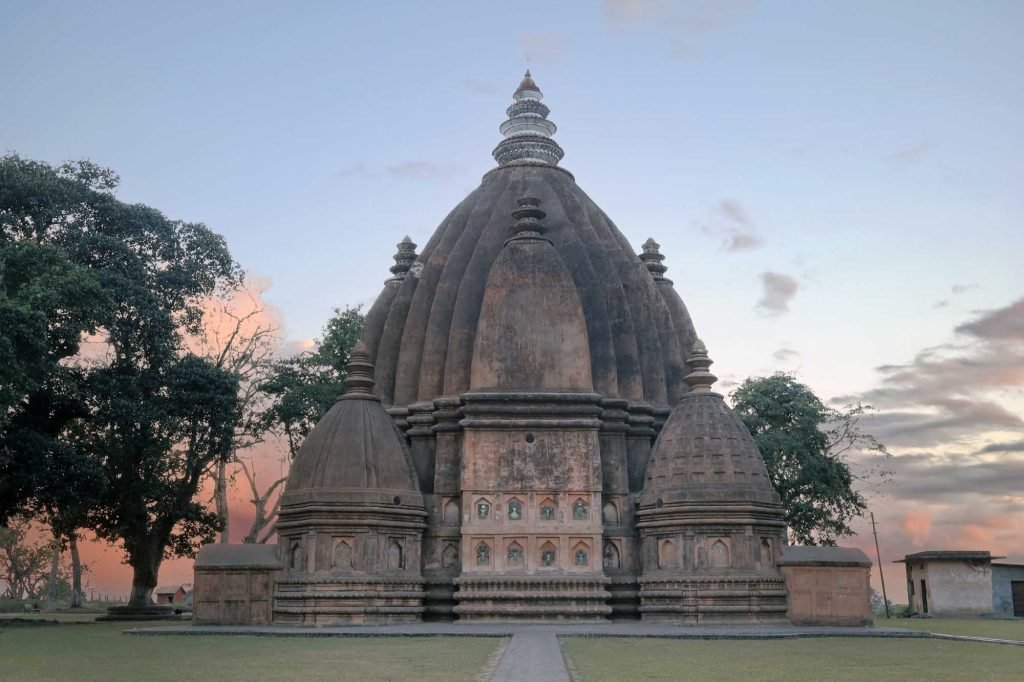The Ahoms: By the thirteenth century, the Ahoms, a Shan tribe entered into the Upper Assam through Patkai hills under the able leadership of Sukapha (CE 1128-68). Subsequent Ahom rulers brought entire Brahmaputra valley under their domain and ruled upto AD 1826. Afterwards the British rule commenced in Assam. Some of the kingdoms contemporary to the Ahoms were the Koches and the Cachari rulers. Both of them belonged to the Tibeto-Burman affiliation. The dynasty ruled various part of the state during the medieval period of Assam.
The Cacharis: The formation of the Cachari state can be seen from the remnants of forts, carved monoliths, tanks, gateway etc. on the bank of Dhansiri river. Cacharis ruled from the capital at Dimapur. During 1536 CE the Cacharis were driven out by the Ahoms and subsequently they shifted their capital at Maibong in the North Cachar Hills in Assam. The inscribed stone by Megha Narayana in 1576 CE at Maibong states about the erection of a gateway (Singhadwara) in the capital complex at Maibong. They were the worshippers of Hara Gauri. King Harish Chandra Narayana in CE 1721 constructed a monolith temple and dedicated to godess Ranachandi. The Cachari rulers Hari Chandra Narayana (1722 CE) and Govind Chandra (1814AD) were also the worshippers of goddess Ranachandi. The kingdom was finally annexed with the British territory after the death of king Govinda Chandra in CE 1830.
The Kochs: The rulers of Koch kingdom were the contemporary of the Ahoms. Formation of the Koch kingdom can be traced back to 16th century CE. The founder of the dynasty is Visva Singha (CE 1515-40) who established the Koch kingdom when Kamarupa Kamata kingdom was in chaos. He ruled from his capital Cooch-Bihar.
After the death of Visva Singha, his son naranarayana ascended the throne in 1540 CE. The rule of Koch kings reached the zenith during the reign of Naranarayana. The Ahom suffered defeat during his reign in 1562. Chilarai, brother of Naranarayana and Commander-in-Chief of the Koch kingdom annexed most of the neighbouring kingdoms of the Cacharis, Manipur, Tripura, Jaintia and Srihatta. After the death of Naranarayana the Koch kings could not retain the past glory.
The architectural tradition of Assam is not earlier than fifth century CE. Literary tradition narrates the construction of religious and secular structures by the ancient rulers of Assam. The Tezpur inscription of Vanamala Varman dated to 9th century AD credited the king built a lofty shrine dedicated to Siva. Nagaon grant of Balavarman refers to the magnificent palace of Vanamal Varman. Bargaon inscription also refers to scintillating description of ‘Durjay’ the capital of the Palas of Assam. None of the structures referred above now exist due to the vagaries of nature.
The finest example of the earliest architecture of Assam can be seen at Dah-Parbatia near Tezpur dated back to c.6th century CE. The exquisitely carved doorframe with figures of Ganga and Yamuna standing at the doorjambs are considered to be of Gupta age. The masonry remains of other temple ruins can be seen at various places of Assam, mention to be made of ruins at Bamuni hill, Singri hill on the the northern bank of Brahmaputra, the cave ruins at Jogigopha and Sri Suryapahar in the lower Assam, remains at deopani and Numuligarh in upper Assam, the temple of Kamakhya of 16th century which was rebuilt by the Koches over the earlier basement of 7th century AD and at many other places of the Brahmaputra valley where the archaeological remains can be seen. The execution of the art forms in the ancient Assam shows the affiliation of the Indian art tradition distinctly.
Departure from the mainstream art tradition, as referred above, can be seen after the advent of the Ahom and Koch powers in the medieval history of assam. The sikaras of the temples appear dome like rather than spire and some of the temples are marked with barrel shaped vaulted top. The outer walls of the masonry temples are found embellished with the treacotta and stone plaques all-around their exterior surface depicting Brahmanical gods and goddesses but execution of workmanship is poor with low relief and flat treatment.
Information courtesy: Archaeological Survey of India, Guwahati Circle.
